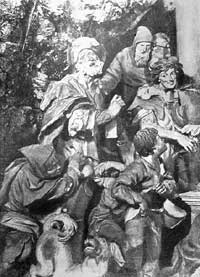 The National Museum of Ancient Art in Portugal preserves, among other valuable works, the nativity scene from the church of St. Vincent de Fora sculpted by Joaquim Machado de Castro in the eighteenth century. In our photograph, we present one detail from this nativity scene: the shepherds coming to adore the Infant Jesus.
The National Museum of Ancient Art in Portugal preserves, among other valuable works, the nativity scene from the church of St. Vincent de Fora sculpted by Joaquim Machado de Castro in the eighteenth century. In our photograph, we present one detail from this nativity scene: the shepherds coming to adore the Infant Jesus.
Even though the intention of the sculptor was to present people from the hills of Judea at the time of the birth of Our Lord, rugged and tattered as the shepherds in the East often were, the human types, countenances, gestures and ways of being that he imagined in this work better resemble the people in the ambience surrounding the artist, that is, the good country people of eighteenth-century Portugal.
At first glance, this scene may give some observers a sensation of disorder. We are accustomed to the disciplined and soulless masses of today’s great modern cities,which we see silently filling the movie theaters or frowning and hurriedly crossing at the street corners when the policeman’s whistle or traffic light stops the flow of vehicles so that they can pass. These multitudes shout and applaud in large collective manifestations as if they were only one immense being in which the individuals had been dissolved like drops of water in the sea.
From this perspective, this cluster of people causes surprise. All, having heard the angelic message, are rushing to the manger. Even the dog, in the foreground, is hurrying. The personal note of each figure is so distinct that the group when considered as a whole emits something of a feeling of effervescence and chaos.
And, in fact, each face and each way of walking or running expresses a completely personal reaction in relation to the Good News. The two young lads in front seem simply moved by curiosity. It is that true nonchalance, often times excessive, that belongs to their age. A more mature shepherd, his eyes shining and dilated with happiness, his expression intelligent, seems to sense with greater discernment the scope of the grand event. Behind him, an old man with a hat with a large upturned brim cries out and weeps from emotion. In the background, a hooded and white-bearded man, hastening even while he meditates, shows himself to be deeply affected.
Each soul in this group of lucid unlettered men is like an interior world from which pours forth the expression of a powerful personality.
Ignorant, illiterate, they were not subjected to the terrible processes of standardization of the twentieth-century mechanical civilization. Their thinking was not imposed upon them by the same newspapers, their sensibilities modeled by the same movies, their attention held all day by the magnetic attraction of radio and television.
And this makes us think of that admirable excerpt-never sufficiently cited-of Pius XII about “the people and the masses”:
“The people, and a shapeless multitude (or, as it is called, `the masses’) are two distinct concepts.
“The people lives and moves by its own life energy; the masses are inert of themselves and can only be moved from outside. The people live by the fulness of life in the men that compose it, each of whom-at his proper place and in his own way-is a person conscious of his own responsibility and of his own views.
“The masses, on the contrary, wait for the impulse from outside, an easy plaything in the hands of anyone who exploits their instincts and impressions; ready to follow in turn, today this flag, tomorrow another.
“From the exuberant life of a true people, an abundant rich life is diffused in the state and all its organs, instilling into them, with a vigor that is always renewing itself, the consciousness of their own responsibility, the true instinct for the common good” (1944 Christmas radio message).

